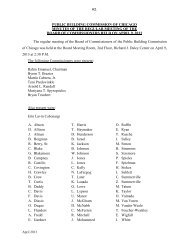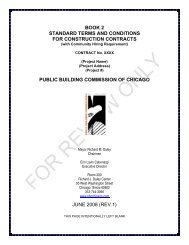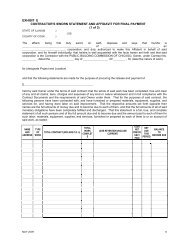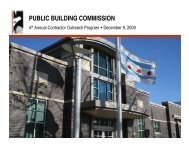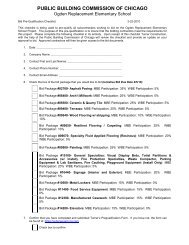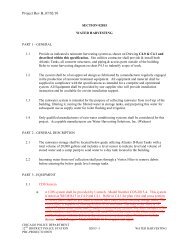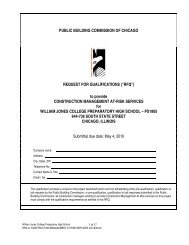Water Reuse Handbook - the Public Building Commission of Chicago
Water Reuse Handbook - the Public Building Commission of Chicago
Water Reuse Handbook - the Public Building Commission of Chicago
You also want an ePaper? Increase the reach of your titles
YUMPU automatically turns print PDFs into web optimized ePapers that Google loves.
<strong>Water</strong> <strong>Reuse</strong> <strong>Handbook</strong><br />
26 : <strong>Public</strong> <strong>Building</strong> <strong>Commission</strong> <strong>of</strong> <strong>Chicago</strong><br />
UV in storage tank: If UV purification is used, an additional UV light<br />
and water agitator should be placed in <strong>the</strong> storage tank to continue<br />
disinfection. As an alternative to placing ano<strong>the</strong>r UV light in <strong>the</strong> tank,<br />
greywater may be recirculated past <strong>the</strong> UV light to provide continual<br />
disinfection; however, this may heat <strong>the</strong> water over time.<br />
Ozone: Ozone, although not as widely used as <strong>the</strong> o<strong>the</strong>r two<br />
purification methods, may be used as an alternative to UV or chlorine<br />
disinfection. The greywater should be afforded adequate contact time<br />
with <strong>the</strong> ozone system. Provisions must be made to <strong>of</strong>f-gas <strong>the</strong> ozone<br />
to a safe environment. In addition, since ozone is a hazardous and<br />
powerful treatment method, its use may be better suited for larger<br />
scale applications where maintenance staff is on-hand to monitor <strong>the</strong><br />
system closely.<br />
Ultra filtration: Due to <strong>the</strong> contaminants that may be present in<br />
greywater, one option is to include ultra filtration membranes as an<br />
alternative filtering mechanism. Ultra filtration is very effective in<br />
removing pathogens, bacteria, viruses, and o<strong>the</strong>r particulate matter<br />
to 0.02 microns or better (see chart on page 54). Ultra filtration is<br />
also more efficient than o<strong>the</strong>r methods <strong>of</strong> filtration, consistent in its<br />
results regardless <strong>of</strong> load, easy to manage, and, when combined with<br />
chlorine purification, will produce pathogen-free water.<br />
Reverse osmosis: Reverse osmosis is a technique which can filter<br />
water to an even finer grain than ultra filtration, down to 0.001<br />
microns or less. Reverse osmosis (RO) is similar to ultra filtration,<br />
although <strong>the</strong>re are some key differences. It works by applying<br />
pressure to <strong>the</strong> solution when it is on one side <strong>of</strong> a selective<br />
membrane, forcing pure solution to filter through while unwanted<br />
molecules and ions stay behind.<br />
Depending on <strong>the</strong> contaminants that may be present in <strong>the</strong> water<br />
to be reused, reverse osmosis may be considered as an alternative<br />
to sand filtration. An activated carbon filter may be needed to trap<br />
organic chemicals and chlorine, which will attack and degrade certain<br />
types <strong>of</strong> reverse osmosis membranes.<br />
Tools and Strategies: Greywater System Design<br />
August 2011



